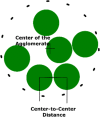Towards better understanding the stiffness of nanocomposites via parametric study of an analytical model modeling parameters and experiments
- PMID: 36974194
- PMCID: PMC10037548
- DOI: 10.1177/00219983221149122
Towards better understanding the stiffness of nanocomposites via parametric study of an analytical model modeling parameters and experiments
Abstract
The stiffness of polymeric materials can be improved dramatically with the addition of nanoparticles. In theory, as the nanoparticle loading in the polymer increases, the nanocomposite becomes stiffer; however, experiments suggest that little or no stiffness improvement is observed beyond an optimal nanoparticle loading. The mismatch between the theoretical and experimental findings, particularly at high particle loadings, needs to be understood for the effective use of nanoparticles. In this respect, we have recently developed an analytical model to close the gap in the literature and predict elastic modulus of nanocomposites. The model is based on a three-phase Mori-Tanaka model coupled with the Monte-Carlo method, and satisfactorily captures the experimental results, even at high nanoparticle loadings. The developed model can also be used to study the effects of agglomeration in nanocomposites. In this paper, we use this model to study the effects of agglomeration and related model parameters on the stiffness of nanocomposites. In particular, the effects of particle orientation, critical distance, dispersion state and agglomerate property, and particle aspect ratio are investigated to demonstrate capabilities of the model and to observe how optimal particle loading changes with respect these parameters. The study shows that the critical distance defining agglomerates and the properties of agglomerates are the key design parameters at high particle loadings. These two parameters rule the optimal elastic modulus with respect to particle loading. The findings will allow researchers to form design curves and successfully predict the elastic moduli of nanocomposites without the exhaustive experimental undertakings.
Keywords: Monte-Carlo; Nanocomposite; modeling; mori-tanaka; parametric study.
© The Author(s) 2023.
Conflict of interest statement
The author(s) declared no potential conflicts of interest with respect to the research, authorship, and/or publication of this article.
Figures








Similar articles
-
A predictive model towards understanding the effect of reinforcement agglomeration on the stiffness of nanocomposites.J Compos Mater. 2022 May;56(10):1591-1604. doi: 10.1177/00219983221076639. Epub 2022 Mar 21. J Compos Mater. 2022. PMID: 35464628 Free PMC article.
-
Effects of Silica Nanoparticles on the Piezoelectro-Elastic Response of PZT-7A-Polyimide Nanocomposites: Micromechanics Modeling Technique.Polymers (Basel). 2024 Oct 10;16(20):2860. doi: 10.3390/polym16202860. Polymers (Basel). 2024. PMID: 39458687 Free PMC article.
-
Prediction of elastic properties for polymer-particle nanocomposites exhibiting an interphase.Nanotechnology. 2011 Apr 22;22(16):165703. doi: 10.1088/0957-4484/22/16/165703. Epub 2011 Mar 11. Nanotechnology. 2011. PMID: 21393814
-
A Review on the Modeling of the Elastic Modulus and Yield Stress of Polymers and Polymer Nanocomposites: Effect of Temperature, Loading Rate and Porosity.Polymers (Basel). 2022 Jan 18;14(3):360. doi: 10.3390/polym14030360. Polymers (Basel). 2022. PMID: 35160350 Free PMC article. Review.
-
Synergic Effect of TiO2 Filler on the Mechanical Properties of Polymer Nanocomposites.Polymers (Basel). 2021 Jun 20;13(12):2017. doi: 10.3390/polym13122017. Polymers (Basel). 2021. PMID: 34203085 Free PMC article. Review.
Cited by
-
Nano-Enhanced Polymer Composite Materials: A Review of Current Advancements and Challenges.Polymers (Basel). 2025 Mar 26;17(7):893. doi: 10.3390/polym17070893. Polymers (Basel). 2025. PMID: 40219283 Free PMC article. Review.
-
Modulated Optoelectronic Properties of MOF/CNF Bionanocomposite Films for Bacterial Growth Control under Visible Light.ACS Appl Mater Interfaces. 2025 May 21;17(20):30006-30018. doi: 10.1021/acsami.5c04982. Epub 2025 May 10. ACS Appl Mater Interfaces. 2025. PMID: 40347151 Free PMC article.
References
-
- Fornes TD, Paul DR. Modeling properties of nylon 6/clay nanocomposites using composite theories. Polymer (Guildf) 2003; 44: 4993–5013. DOI: 10.1016/S0032-3861(03)00471-3 - DOI
-
- Sheng N, Boyce MC, Parks DM, et al. Multiscale micromechanical modeling of polymer/clay nanocomposites and the effective clay particle. Polymer (Guildf) 2004; 45: 487–506. DOI: 10.1016/j.polymer.2003.10.100 - DOI
-
- Vera-Agullo J, Glória-Pereira A, Varela-Rizo H, et al. Comparative study of the dispersion and functional properties of multiwall carbon nanotubes and helical-ribbon carbon nanofibers in polyester nanocomposites. Compos Sci Technol 2009; 69: 1521–1532. DOI: 10.1016/j.compscitech.2008.11.032 - DOI
-
- Shi D-L, Feng X-Q, Huang YY, et al. The effect of nanotube waviness and agglomeration on the elastic property of carbon nanotube-reinforced composites. J Eng Mater Technol Trans ASME 2004; 126: 250–257. DOI: 10.1115/1.1751182 - DOI
-
- Corrêa AC, Teodoro KBR, Simão JA, et al. Cellulose nanocrystals from curaua fibers and poly[ethylene-co-(vinyl acetate)] nanocomposites: effect of drying process of CNCs on thermal and mechanical properties. Polym Compos 2020; 41: 1736–1748. DOI: 10.1002/pc.25493 - DOI
LinkOut - more resources
Full Text Sources
Miscellaneous
